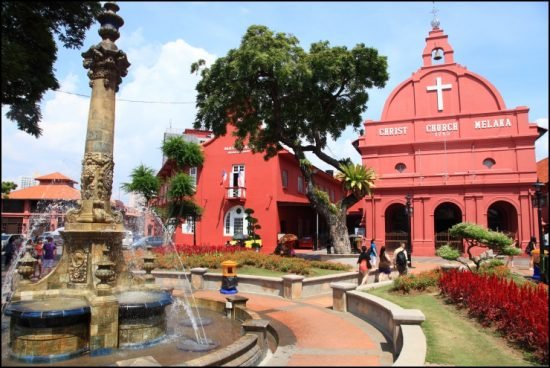Malaysia is a beautiful country filled with lots of interesting, beautiful and unique travel destinations. So why are these must-visit places? Not only because they are places that form a crucial part of our country’s sejarah (history), but also as Malaysians, it is our civic duty to visit these places at least once in our lives. Otherwise how la to call yourself a Malaysian, kan? Also, it’s a good idea to support the country’s economy #cuticutimalaysia and tourism. (It will also come in handy when you have friends or relatives from overseas because you can bring them around like a pro.)
Tugu Negara (National Monument)
The National Monument (Tugu Negara) is a sculpture that commemorates those who died in Malaysia’s struggle for freedom, principally against the Japanese occupation during World War II and the Malayan Emergency, which lasted from 1948 until 1960. It is located in Kuala Lumpur, nearby Lake Gardens. The monument depicts a group of soldiers holding the Malaysian national flag. Each of the bronze figures symbolizes leadership, suffering, unity, vigilance, strength, courage and sacrifice.
Dataran Merdeka, KL
Dataran Merdeka, or Independence Square, is a big open field located in the city centre, in front of the historical Sultan Abdul Samad building. It was here that the Union Flag was lowered and the Malayan flag raised for the first time at midnight on 31 August 1957, which makes it an important historical landmark. It is also the usual venue for the annual Merdeka parade. If you’re hungry for some great grub, the Kuala Lumpur Food Truck Feast (KLFTF) held every first and third weekend offers an amazing variety of street food sold from food trucks in front of Panggung DBKL near Dataran Merdeka.

Petronas Twin Towers (KLCC)
Probably the most iconic building in Malaysia, the Petronas Twin Towers stands proud as the tallest twin buildings in the world, at a height of 452m. The 88-floor towers are constructed largely of reinforced concrete, with a steel and glass facade designed to resemble motifs found in Islamic art, which reflects the nation’s official religion. Also fondly known as jagung (corn) by locals due to its shape, it is a popular shopping and tourist destination. The KLCC Park at its base is the perfect spot for a relaxing stroll, family picnic or hunting Pokemon.
Menara KL (KL Tower)
Another unmistakeable tower in the KL skyline, KL Tower was completed in 1995 with a height of 421m. It is the 7th tallest freestanding tower in the world, and is the symbol of Kuala Lumpur. It is used for telecommunications and broadcasting purposes. Did you know? Races are held here annually, where participants race up the stairs to the top of the tower! If you fancy some food, there’s a revolving restaurant which allows you to enjoy delicious local and international cuisine along with a panoramic view of the city.
Dutch Square, Melaka
Mention Melaka, and the first thing that comes to mind for most Malaysians would definitely be the iconic red buildings at Dutch Square, also known as Red Square. The Stadthuys (which means city hall in Dutch) is known for its red exterior and red clock tower. The similarly coloured Christ Church next to it is the oldest functioning Protestant church in Malaysia.
 Melaka Sultanate Palace Museum
Melaka Sultanate Palace Museum
The Melaka Sultanate Palace Museum is a wooden replica of Sultan Mansur Shah’s 15th-century palace. According to Sejarah Melayu (Malay Annals), the elaborate seven-tiered palace was built entirely without nails and supported with carved wooden pillars, featuring a copper and zinc roof. It was burnt down when struck by lightning. The Cultural Museum (Muzium Kebudayaan) was reconstructed using traditional construction techniques and materials based on historical account, and currently houses many historical artifacts detailing the Malay Sultanate’s history and cultural heritage.
Peranakan Green Mansion, Penang
A trip to Penang would not be complete without a trip to the cultural gem that is the Peranakan Green Mansion, which was built in the 19th century. The mansion was built according to Baba Nyonya culture, by incorporating Chinese crafted wooden panels, alongside British floor tiles and Scottish ironwork. More than 1,000 pieces of well-preserved antiques and collectibles are on display within the mansion, which is famous as a Baba Nyonya museum.
Crystal Mosque, Kuala Terengganu
There are many beautiful and unique mosques in Malaysia, but one of the most remarkable ones is the Crystal Mosque in Kuala Terengganu. It is famous for its interesting facade, which is coated with steel, glass and crystal, which gives it its iconic look and name. Not only does it reflect off the river surrounding the mosque, the illumination from inside also makes it look like it is shining, both inside and outside. Located in the Islamic Heritage Park in Wan Man Island off Terengganu, this mosque is able to accommodate up to 1,500 worshippers at a time and is reknown internationally for its beauty.
Wat Machimmaran, Kelantan
This Buddhist temple in Tumpat, Kelantan houses the largest sitting Buddha statue in Southeast Asia. It took skilled craftsmen from Thailand about 10 years to build the Buddha statue which is 30 meters high and 47 meters wide. In addition to the giant sitting statue, there are also six sandalwood craved Buddha statues in the temple, one of which is over 500 years old. The temple grounds alone measure over 2.4 hectares, and include many other smaller shrines.
 Batu Caves Hindu Temple
Batu Caves Hindu Temple
While Batu Caves is technically the name of the area in Gombak, most people use it to refer to the Hindu temple complex that is built inside the limestone hill there. Rising almost 100 m above the ground, the Batu Caves temple complex consists of three main caves and a few smaller ones. Visitors must climb a steep flight of 272 steps to reach the main Temple Cave. However, it is the giant golden statue outside that is the centre of attraction for tourists. Standing at 42.7m high, it is the world’s tallest statue of Lord Murugan, a Hindu deity. Trust us, if the sitting Buddha statue didn’t impress you, a 140-ft golden statue of a Hindu deity definitely will. Oh, and remember watch out for the sneaky monkeys while you’re there. 😛
Alright! Now that you’re done with visiting these amazing places in Malaysia (with more recommendations coming soon!), why not hop on a bus/train/plane to our neighbour and marvel at these iconic spots in Singapore? 😉







![[Video] MRT 2, Putrajaya Line](https://insight.estate123.com/wp-content/uploads/2022/10/MRT-2-Putrajaya-thumbnail-440x264.png)


